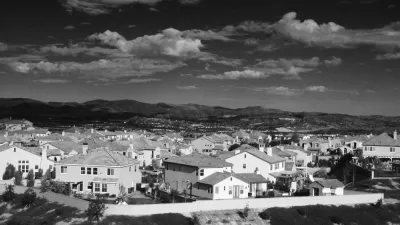It's not a popular viewpoint, but what if suburbs end up being more critical to a sustainable and efficient future than dense urban areas?

Randy Rieland reports on a proposition that might come as a shock, or even an affront, to some who call themselves urbanists: the future of the built environment could still be suburban.
Rieland relies on the ideas and research of Alan Berger, a professor of landscape architecture and urban design at MIT, who recently convened the "Future of Suburbia" conference. Among the speakers and futurists at the event, a much more environmentally friendly portrait of the suburbs emerged:
Their model of a future metropolitan area of 3 million people looks very different from what we’ve come to know. Rather than have neighborhoods continuously spreading outward from a downtown core, it presents a handful of dense clusters amid what Berger describes as a “big sea of suburban development that’s much more horizontal than vertical." It would, he says, function as a “kind of holistic sustainable machine.”
One key concept of Berger's argument: that U.N.'s 2014 "World Urbanization Prospects" report built a misconception that the majority of the world's population now lives in urban areas (i.e., not the suburbs). In fact, says Berger, most of those people are moving to suburbs. "Certainly, the world’s urbanizing, but it’s urbanizing in a much different way than cities," says Berger in a direct quote. "It’s urbanizing horizontally."
FULL STORY: Suburbia Gets No Respect, But It Could Become a Very Different Place

Depopulation Patterns Get Weird
A recent ranking of “declining” cities heavily features some of the most expensive cities in the country — including New York City and a half-dozen in the San Francisco Bay Area.

California Exodus: Population Drops Below 39 Million
Never mind the 40 million that demographers predicted the Golden State would reach by 2018. The state's population dipped below 39 million to 38.965 million last July, according to Census data released in March, the lowest since 2015.

Chicago to Turn High-Rise Offices into Housing
Four commercial buildings in the Chicago Loop have been approved for redevelopment into housing in a bid to revitalize the city’s downtown post-pandemic.

New Park Opens in the Santa Clarita Valley
The City of Santa Clarita just celebrated the grand opening of its 38th park, the 10.5-acre Skyline Ranch Park.

U.S. Supreme Court: California's Impact Fees May Violate Takings Clause
A California property owner took El Dorado County to state court after paying a traffic impact fee he felt was exorbitant. He lost in trial court, appellate court, and the California Supreme Court denied review. Then the U.S. Supreme Court acted.

How Urban Form Impacts Housing Affordability
The way we design cities affects housing costs differently than you might think.
City of Costa Mesa
Licking County
Barrett Planning Group LLC
HUD's Office of Policy Development and Research
Mpact Transit + Community
HUD's Office of Policy Development and Research
City of Universal City TX
ULI Northwest Arkansas
Town of Zionsville
Urban Design for Planners 1: Software Tools
This six-course series explores essential urban design concepts using open source software and equips planners with the tools they need to participate fully in the urban design process.
Planning for Universal Design
Learn the tools for implementing Universal Design in planning regulations.





















